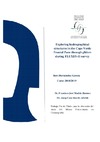Please use this identifier to cite or link to this item:
https://accedacris.ulpgc.es/handle/10553/57932
| DC Field | Value | Language |
|---|---|---|
| dc.contributor.advisor | Machín Jiménez, Francisco José | es |
| dc.contributor.advisor | Coca Saenz De Albéniz, Josep | es |
| dc.contributor.author | Hernández García, Inés | es |
| dc.date.accessioned | 2019-11-18T13:15:55Z | - |
| dc.date.available | 2019-11-18T13:15:55Z | - |
| dc.date.issued | 2019 | - |
| dc.identifier.uri | https://accedacris.ulpgc.es/handle/10553/57932 | - |
| dc.description.abstract | The Cape Verde Frontal Zone (CVFZ) is a dynamically complex region located at the eastern North Atlantic Subtropical Gyre (20ºW to 30ºW, ~20ºN), where the warmer and more saline North Atlantic Central Water (NACW) and the colder and less saline South Atlantic Central Water (SACW) interact. It is defined by the intersection of the 36.0 isohaline with the 150 m depth isobath. It is subjected to high variability, with the presence of lateral intrusions, filaments from the upwelling system and mesoscale and submesoscale eddy fields with a sharp thermohaline gradient. Temperature decrease compensates the salinity decrease with depth, so both variables compensate their effect on density, making the front dynamically stable. The aim of this project is to analyse the features at the CVFZ during November 2017 using the in situ FLUXES-II data, obtained from ship CTD stations, a SeaSoar and two deep gliders with biochemical and dynamical instruments. Data and Copernicus Mercator model outputs were compared to determine their skills to capture the mesoscale and submesoscale features. The variables used on this study were potential temperature, practical salinity, potential density and oxygen concentration. Wavelet analyses were conducted to compare the different scales that can be accessed with the sampling methods. It allows to determine the main wavelengths in the signal, using distance as the independent variable rather than time. Results showed that the ship CTD data reaches the greatest depth of all the sampling methods and the SeaSoar is the fastest method. The glider and the SeaSoar capture the smallest scales and show the features with greater detail, while the glider has a slightly better resolution. | en_US |
| dc.language | eng | en_US |
| dc.subject | 251007 Oceanografía física | en_US |
| dc.subject.other | Cape Verde Frontal Zone | es |
| dc.subject.other | Water masses | es |
| dc.subject.other | Autonomous Underwater Vehicles (gliders) | es |
| dc.subject.other | Remotely Operated Vehicles (SeaSoar) | es |
| dc.subject.other | Numerical models | es |
| dc.subject.other | Wavelet analysis | es |
| dc.subject.other | Mesoscale and submesoscale features | es |
| dc.title | Exploring hydrographical structures in the Cape Verde Frontal Zone through gliders during FLUXES-II survey | es |
| dc.type | info:eu-repo/semantics/masterThesis | en_US |
| dc.type | MasterThesis | en_US |
| dc.contributor.departamento | Departamento de Física | es |
| dc.contributor.facultad | Facultad de Ciencias del Mar | en_US |
| dc.investigacion | Ciencias | en_US |
| dc.type2 | Trabajo final de máster | en_US |
| dc.description.notas | Máster en Oceanografía ; 2018-2019 | en_US |
| dc.utils.revision | Sí | en_US |
| dc.identifier.matricula | TFT-53325 | es |
| dc.identifier.ulpgc | Sí | en_US |
| dc.contributor.buulpgc | BU-BAS | es |
| dc.contributor.titulacion | Máster Universitario en Oceanografía por la Universidad de Cádiz, la Universidad de Las Palmas de Gran Canaria y la Universidad de Vigo | es |
| item.fulltext | Con texto completo | - |
| item.grantfulltext | open | - |
| crisitem.advisor.dept | GIR ECOAQUA: Oceanografía Física y Geofísica Aplicada | - |
| crisitem.advisor.dept | IU de Investigación en Acuicultura Sostenible y Ec | - |
| crisitem.advisor.dept | Departamento de Física | - |
| crisitem.advisor.dept | GIR ECOAQUA: Biodiversidad y Conservación | - |
| crisitem.advisor.dept | IU de Investigación en Acuicultura Sostenible y Ec | - |
| crisitem.author.dept | GIR ECOAQUA: Oceanografía Física y Geofísica Aplicada | - |
| crisitem.author.dept | IU de Investigación en Acuicultura Sostenible y Ec | - |
| crisitem.author.orcid | 0000-0002-6217-7835 | - |
| crisitem.author.parentorg | IU de Investigación en Acuicultura Sostenible y Ec | - |
| crisitem.author.fullName | Hernández García, Inés | - |
| Appears in Collections: | Trabajo final de máster | |
Page view(s)
117
checked on Mar 9, 2024
Download(s)
98
checked on Mar 9, 2024
Google ScholarTM
Check
Share
Export metadata
Items in accedaCRIS are protected by copyright, with all rights reserved, unless otherwise indicated.
